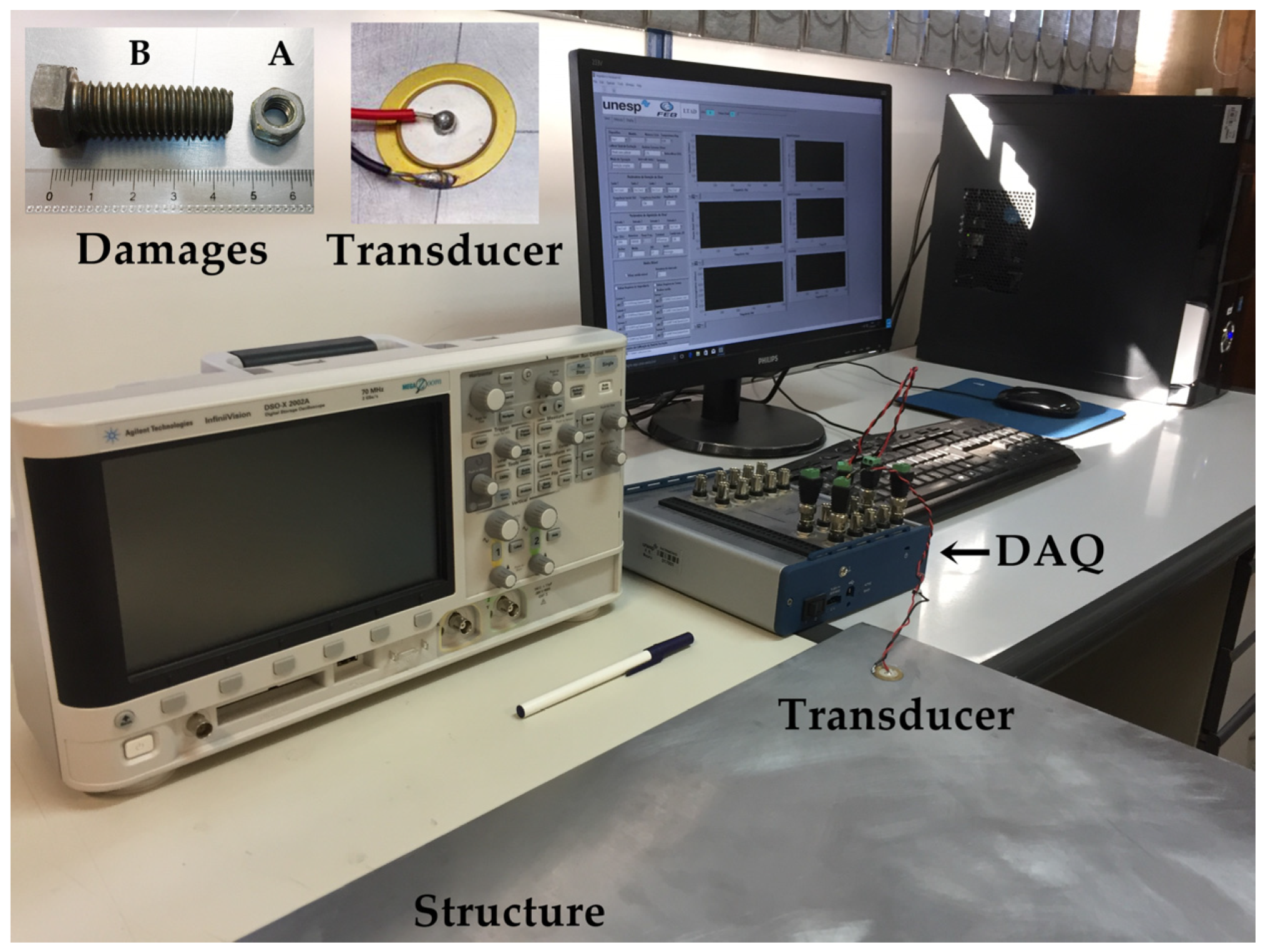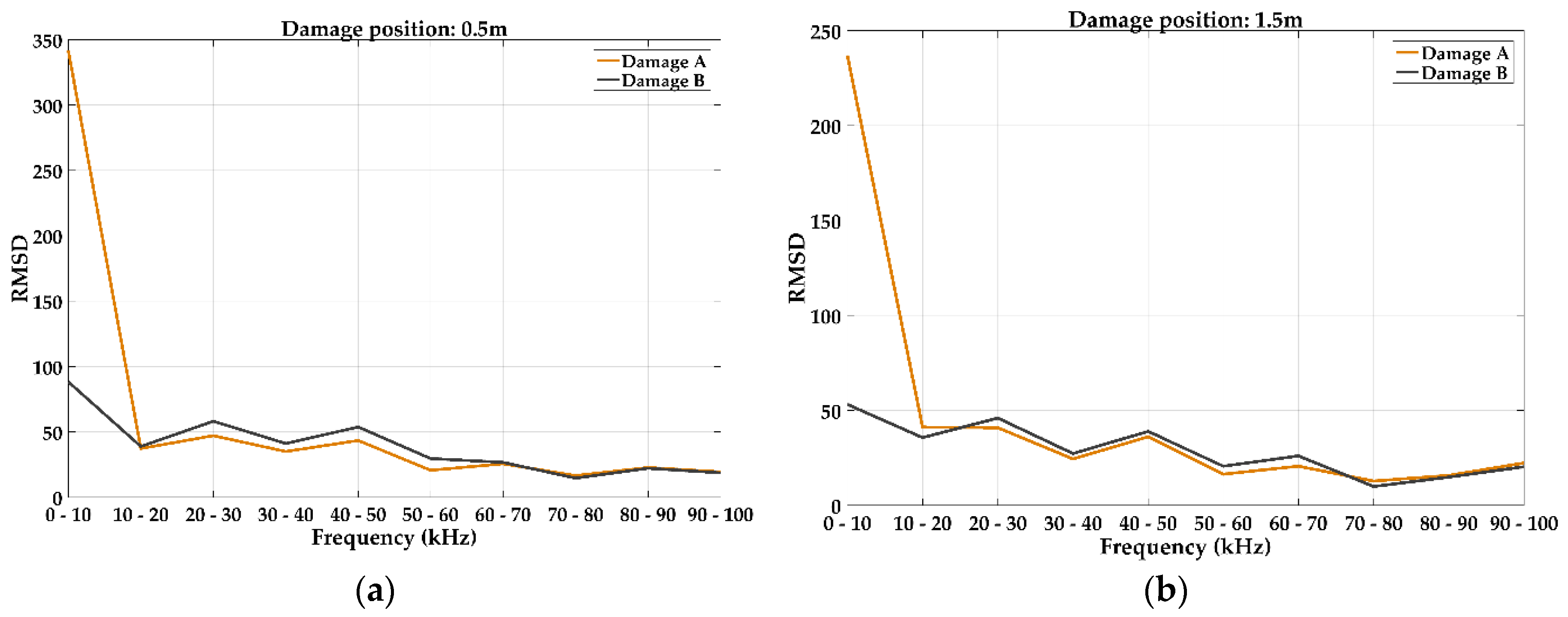Analysis of Piezoelectric Diaphragms in Impedance-Based Damage Detection in Large Structures †
Abstract
:1. Introduction
2. The Electromechanical Impedance (EMI) Technique and Piezoelectric Transducer
3. Experimental Setup
4. Results and Discussion
5. Conclusions
Author Contributions
Acknowledgments
Conflicts of Interest
Abbreviations
| EMI | electromechanical impedance |
| NDT | non-destructive testing |
| PZT | Lead zirconate titanate |
| RMSD | root mean square deviation |
| SHM | structural health monitoring |
References
- Li, H.; Ren, L.; Jia, Z.; Yi, T.; Li, D. State-of-the-art in structural health monitoring of large and complex civil infrastructures. J. Civ. Struct. Health Monit. 2016, 6, 3–16. [Google Scholar] [CrossRef]
- Ostachowicz, W.; Güemes, J.A. New Trends in Structural Health Monitoring, International Centre for Mechanical Sciences, Courses and Lectures; Springer: Vienna, Italy, 2013; p. 434. [Google Scholar]
- Giurgiutiu, V. Embedded NDT with Piezoelectric Wafer Active Sensors. In Nondestructive Testing of Materials and Structures; Buyukozturk, O., Tasdemir, M.A., Gunes, O., Akkaya, Y., Eds.; Springer: Dordrecht, The Netherlands, 2013; Volume 6, pp. 987–992. [Google Scholar]
- Yu, L.; Leckey, C.A.C. Lamb wave-based quantitative crack detection using a focusing array algorithm. J. Intell. Mater. Syst. Struct. 2013, 24, 1138–1152. [Google Scholar] [CrossRef]
- Schmitt, M.; Olfert, S.; Rautenberg, J.; Lindner, G.; Henning, B.; Reindl, L.M. Multi reflection of lamb wave emission in an acoustic waveguide sensor. Sensors 2013, 13, 2777–2785. [Google Scholar] [CrossRef] [PubMed]
- Svečko, R.; Kusić, D.; Kek, T.; Sarjaš, A.; Hančič, A.; Grum, J. Acoustic emission detection of macro-cracks on engraving tool steel inserts during the injection molding cycle using PZT sensors. Sensors 2013, 13, 6365–6379. [Google Scholar] [CrossRef] [PubMed]
- Shahidan, S.; Pulin, R.; Bunnori, N.M.; Holford, K.M. Damage classification in reinforced concrete beam by acoustic emission signal analysis. Constr. Build. Mater. 2013, 45, 78–86. [Google Scholar] [CrossRef]
- Rulli, R.P.; Dotta, F.; da Silva, P.A. Flight tests performed by EMBRAER with SHM systems. Key Eng. Mater. 2013, 558, 305–313. [Google Scholar] [CrossRef]
- García-Martín, J.; Gómez-Gil, J.; Vázquez-Sánchez, E. Non-destructive techniques based on eddy current testing. Sensors 2011, 11, 2525–2565. [Google Scholar] [CrossRef] [PubMed]
- Annamdas, V.G.M.; Radhika, M.A. Electromechanical impedance of piezoelectric transducers for monitoring metallic and non-metallic structures: A review of wired, wireless and energy-harvesting methods. J. Intell. Mater. Syst. Struct. 2013, 24, 1021–1042. [Google Scholar] [CrossRef]
- Baptista, F.G.; Budoya, D.E.; Almeida, V.A.D.; Ulson, J.A.C. An Experimental Study on the Effect of Temperature on Piezoelectric Sensors for Impedance-Based Structural Health Monitoring. Sensors 2014, 14, 1208–1227. [Google Scholar] [CrossRef] [PubMed]
- Freitas, E.S.; Baptista, F.G.; Budoya, D.E.; Castro, B.A. Equivalent circuit of piezoelectric diaphragms for impedance-based structural health monitoring applications. IEEE Sens. J. 2017, 17, 5537–5546. [Google Scholar] [CrossRef]
- Campeiro, L.M.; Silveira, R.Z.M.; Baptista, F.G. Impedance-based damage detection under noise and vibration effects. Struct. Health Monit. 2017, 17, 1–14. [Google Scholar] [CrossRef]
- Baptista, F.G.; Vieira Filho, J.; Inman, D.J. Sizing PZT Transducers in Impedance-Based Structural Health Monitoring. IEEE Sens. J. 2011, 11, 1405–1414. [Google Scholar] [CrossRef]
- Baptista, F.G.; Vieira Filho, J. A new impedance measurement system for PZT-based structural health monitoring. IEEE Trans. Inst. Meas. 2009, 58, 3602–3608. [Google Scholar] [CrossRef]





Publisher’s Note: MDPI stays neutral with regard to jurisdictional claims in published maps and institutional affiliations. |
© 2018 by the authors. Licensee MDPI, Basel, Switzerland. This article is an open access article distributed under the terms and conditions of the Creative Commons Attribution (CC BY) license (https://creativecommons.org/licenses/by/4.0/).
Share and Cite
Budoya, D.; Castro, B.d.; Campeiro, L.; Silveira, R.d.; Freitas, E.d.; Baptista, F. Analysis of Piezoelectric Diaphragms in Impedance-Based Damage Detection in Large Structures. Proceedings 2018, 2, 131. https://doi.org/10.3390/ecsa-4-04896
Budoya D, Castro Bd, Campeiro L, Silveira Rd, Freitas Ed, Baptista F. Analysis of Piezoelectric Diaphragms in Impedance-Based Damage Detection in Large Structures. Proceedings. 2018; 2(3):131. https://doi.org/10.3390/ecsa-4-04896
Chicago/Turabian StyleBudoya, Danilo, Bruno de Castro, Leandro Campeiro, Ricardo da Silveira, Everaldo de Freitas, and Fabricio Baptista. 2018. "Analysis of Piezoelectric Diaphragms in Impedance-Based Damage Detection in Large Structures" Proceedings 2, no. 3: 131. https://doi.org/10.3390/ecsa-4-04896
APA StyleBudoya, D., Castro, B. d., Campeiro, L., Silveira, R. d., Freitas, E. d., & Baptista, F. (2018). Analysis of Piezoelectric Diaphragms in Impedance-Based Damage Detection in Large Structures. Proceedings, 2(3), 131. https://doi.org/10.3390/ecsa-4-04896





